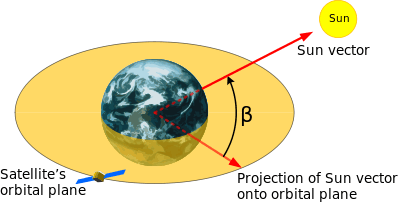Beta angle

The beta angle () is a measurement that is used most notably in spaceflight. The beta angle determines the percentage of time an object such as a spacecraft in low Earth orbit (LEO) spends in direct sunlight, absorbing solar energy.[1] Beta angle is defined as the angle between the orbital plane of the spacecraft and the vector to the sun (i.e., which direction the Sun is shining from).[2] The beta angle is the smaller angle (there are two angles) between the Sun vector (where the Sun is shining from in the sky) and the plane of the object's orbit. Note that the beta angle does not define a unique orbit plane; all satellites in orbit with a given beta angle at a given altitude have the same exposure to the Sun, even though they may be orbiting in completely different planes around the Earth.[3] The beta angle varies between +90° and −90°, and the direction the satellite revolves around the body it orbits determines whether the beta angle sign is positive or negative. An imaginary observer standing on the Sun defines a beta angle as positive if the satellite in question orbits in a counter clockwise direction and negative if it revolves clockwise.[3] The maximum amount of time that a satellite in a normal low Earth orbit mission can spend in the Earth's shadow occurs at a beta angle of zero. In such an orbit, the satellite is in sunlight no more than 59% of the time.[1][2]
Light and shadow
The degree of orbital shadowing an object in LEO experiences is determined by that object's beta angle. An object launched into an initial orbit with an inclination equal to the complement of the Earth's inclination to the ecliptic results in an initial beta angle of 0 degrees ( = 0°) for the orbiting object. This allows the object to spend the maximum possible amount of its orbital period in the Earth's shadow, and results in extremely reduced absorption of solar energy. At a LEO of 280 kilometers, the object is in sunlight through 59% of its orbit (approximately 53 minutes in Sunlight, and 37 minutes in shadow.[2]) On the other extreme, an object launched into an orbit parallel to the terminator results in a beta angle of 90 degrees ( = 90°), and the object is in sunlight 100% of the time.[2] An example would be a polar orbit initiated at local dawn or dusk on an equinox. Beta angle can be controlled to keep a satellite as cool as possible (for instruments that require low temperatures, such as infrared cameras) by keeping the beta angle as close to zero as possible, or, conversely, to keep a satellite in sunlight as much as possible (for conversion of sunlight by its solar panels, for solar stability of sensors, or to study the Sun) by maintaining a beta angle as close to +90 or -90 as possible.
Determination and application of beta angles
The above discussion defines the beta angle of satellites orbiting the Earth, but a beta angle can be calculated for any orbiting three body system: the same definition can be applied to give the beta angle of other objects. For example, the beta angle of a satellite in orbit around Mars, with respect to the Earth, defines how much of the time the satellite has a line of sight to the Earth - that is, it determines how long the Earth is shining on the satellite and how long the Earth is blocked from view. That same satellite also will have a beta angle with respect to the Sun, and in fact it has a beta angle for any celestial object one might wish to calculate one for: any satellite orbiting a body (i.e. the Earth) will be in that body's shadow with respect to a given celestial object (like a star) some of the time, and in its line-of-sight the rest of the time. Beta angles describing non-geocentric orbits are important when space agencies launch satellites into orbits around other bodies in the Solar System.
Importance in spaceflight
When the space shuttle was in service on missions to the International Space Station, the beta angle of the space station's orbit was a crucial consideration; periods referred to as "beta cutout",[1] during which the shuttle could not safely be launched to the ISS, were a direct result of the beta angle of the space station at those times. When the orbiter was in-flight (not docked to ISS) and it flew to a beta angle greater than 60 degrees, the orbiter went into "rotisserie" mode, and slowly rotated around its X-axis (nose to tail axis). For flights to ISS, the shuttle could launch during an ISS beta cutout if the ISS would be at a beta less than 60 degrees at dock, and throughout the docked phase. Therefore, the mission duration affected launch timing when the beta cutout dates were approaching.
See also
References
- 1 2 3 Derek Hassman, NASA Flight Director (December 1, 2002). "MCC Answers". NASA. Retrieved June 14, 2009.
- 1 2 3 4 K&K Associates (2008). "Earth's Thermal Environment". Thermal Environments JPL D-8160. K&K Associates. Retrieved July 14, 2009.
- 1 2 "Orbit Definition". 2001 Structural Dynamics Research Corporation. Retrieved August 26, 2009.